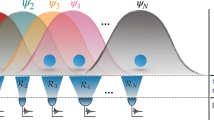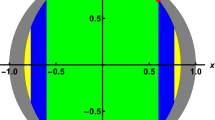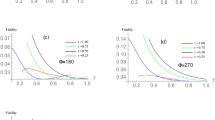Abstract
The existence of better-than-classical quantum information processing (QIP) models which consume very little or no entanglement suggests that separable or weakly entangled states could be extremely useful tools for information processing as they are much easier to prepare and control even in dissipative environments. It has been proposed that a resource of advantage is the generation of quantum discord, a measure of non-classical correlations that includes entanglement as a subset. Here we show that quantum discord is the necessary resource for quantum remote state preparation. We explicitly show that the geometric measure of quantum discord is related to the fidelity of this task, which provides its operational meaning. Our results are experimentally demonstrated using photonic quantum systems. Moreover, we demonstrate that separable states with non-zero quantum discord can outperform entangled states. Therefore, the role of quantum discord might provide fundamental insights for resource-efficient QIP.
This is a preview of subscription content, access via your institution
Access options
Subscribe to this journal
Receive 12 print issues and online access
$209.00 per year
only $17.42 per issue
Buy this article
- Purchase on Springer Link
- Instant access to full article PDF
Prices may be subject to local taxes which are calculated during checkout


 for 58 distinct states on Bob’s Bloch sphere.
for 58 distinct states on Bob’s Bloch sphere.
Similar content being viewed by others
References
Schrödinger, E. Discussion of probability relations between separated systems. Math. Proc. Cambridge Phil. Soc. 31, 555–563 (1935).
Nielsen, M. A. & Chuang, I. L. Quantum Computation and Quantum Information (Cambridge Univ. Press, 2000).
Buhrman, H., Cleve, R., Massar, S. & de Wolf, R. Nonlocality and communication complexity. Rev. Mod. Phys. 82, 665–698 (2010).
Brukner, Č., Zukowski, M., Pan, J-W. & Zeilinger, A. Bell’s inequalities and quantum communication complexity. Phys. Rev. Lett. 92, 127901–127905 (2004).
Ekert, A. K. Quantum cryptography based on Bell’s theorem. Phys. Rev. Lett. 67, 661–665 (1991).
Monz, T. et al. 14-qubit entanglement: Creation and coherence. Phys. Rev. Lett. 106, 130506–130510 (2011).
Yao, X. et al. Observation of eight-photon entanglement. Nature Photon. 6, 225–228 (2012).
Huang, Y. et al. Experimental generation of an eight-photon Greenberger–Horne–Zeilinger state. Nature Commun. 2, 546–552 (2011).
Jozsa, R. & Linden, N. On the role of entanglement in quantum-computational speed-up. Proc. R. Soc. Lond. Ser. A 459, 2011–2032 (2003).
Knill, E. & Laflamme, R. Power of one bit of quantum information. Phys. Rev. Lett. 81, 5672–5675 (1998).
Meyer, D. A. Sophisticated quantum search without entanglement. Phys. Rev. Lett. 85, 2014–2017 (2000).
Ryan, C. A., Emerson, J., Poulin, D., Negrevergne, C. & Laflamme, R. Characterization of complex quantum dynamics with a scalable NMR information processor. Phys. Rev. Lett. 95, 250502–250507 (2005).
Lanyon, B. P., Barbieri, M., Almeida, M. P. & White, A. G. Experimental quantum computing without entanglement. Phys. Rev. Lett. 101, 200501–200505 (2008).
Passante, G., Moussa, O., Trottier, D. A. & Laflamme, R. Experimental detection of nonclassical correlations in mixed-state quantum computation. Phys. Rev. A 84, 044302–044306 (2011).
Ollivier, H. & Zurek, W. H. Quantum discord: A measure of the quantumness of correlations. Phys. Rev. Lett. 88, 017901–017905 (2001).
Zurek, W. H. Einselection and decoherence from an information theory perspective. Annalen der Physik 512, 855–864 (2000).
Henderson, L. & Vedral, V. Classical, quantum and total correlations. J. Phys. A 34, 6899–6909 (2001).
Datta, A., Shaji, A. & Caves, C. M. Quantum discord and the power of one qubit. Phys. Rev. Lett. 100, 050502–050507 (2008).
Cavalcanti, D. et al. Operational interpretations of quantum discord. Phys. Rev. A 83, 032324–032329 (2011).
Madhok, V. & Datta, A. Interpreting quantum discord through quantum state merging. Phys. Rev. A 83, 032323–032327 (2011).
Madhok, V. & Datta, A. Role of quantum discord in quantum communication. Preprint at http://arxiv.org/abs/1107.0994 (2011).
Piani, M., Horodecki, P. & Horodecki, R. No-local-broadcasting theorem for multipartite quantum correlations. Phys. Rev. Lett. 100, 090502–090507 (2008).
Roa, L., Retamal, J. C. & Alid-Vaccarezza, M. Dissonance is required for assisted optimal state discrimination. Phys. Rev. Lett. 107, 080401–080405 (2011).
Datta, A., Flammia, S. T. & Caves, C. M. Entanglement and the power of one qubit. Phys. Rev. A 72, 042316–042330 (2005).
Braunstein, S. L. et al. Separability of very noisy mixed states and implications for NMR quantum computing. Phys. Rev. Lett. 83, 1054–1057 (1999).
Dakić, B., Vedral, V. & Brukner, Č. Necessary and sufficient condition for nonzero quantum discord. Phys. Rev. Lett. 105, 190502–190506 (2010).
Ferraro, A., Aolita, L., Cavalcanti, D., Cucchietti, F. M. & Acín, A. Almost all quantum states have nonclassical correlations. Phys. Rev. A 81, 052318–052324 (2010).
Pati, A. K. Minimum classical bit for remote preparation and measurement of a qubit. Phys. Rev. A 63, 014302–014306 (2000).
Bennett, C. H. et al. Remote state preparation. Phys. Rev. Lett. 87, 077902–077907 (2001).
Bennett, C. H. et al. Teleporting an unknown quantum state via dual classical and Einstein–Podolsky–Rosen channels. Phys. Rev. Lett. 70, 1895–1899 (1993).
Groisman, B., Popescu, S. & Winter, A. Quantum, classical, and total amount of correlations in a quantum state. Phys. Rev. A 72, 032317–032328 (2005).
Datta, A. Studies on the Role of Entanglement in Mixed-state Quantum Computation. Ph.D. thesis, The Univ. New Mexico (2008).
Horodecki, R. & Horodecki, M. Information-theoretic aspects of inseparability of mixed states. Phys. Rev. A 54, 1838–1843 (1996).
Modi, K., Brodutch, A., Cable, H., Paterek, T. & Vedral, V. Quantum discord and other measures of quantum correlation Preprint at http://arxiv.org/abs/1112.6238 (2011).
Chiuri, A., Vallone, G., Paternostro, M. & Mataloni, P. Extremal quantum correlations: Experimental study with two-qubit states. Phys. Rev. A 84, 020304–020308 (2011).
Luo, S. & Fu, S. Geometric measure of quantum discord. Phys. Rev. A 82, 034302–034306 (2010).
Bennett, C., Hayden, P., Leung, D., Shor, P. & Winter, A. Remote preparation of quantum states. Inf. Theory IEEE Trans. 51, 56–74 (2005).
Werner, R. F. Quantum states with Einstein–Podolsky–Rosen correlations admitting a hidden-variable model. Phys. Rev. A 40, 4277–4281 (1989).
Wootters, W. K. Entanglement of formation of an arbitrary state of two qubits. Phys. Rev. Lett. 80, 2245–2248 (1998).
Chaves, R. & de Melo, F. Noisy one-way quantum computations: The role of correlations. Phys. Rev. A 84, 022324–022334 (2011).
Lavoie, J., Kaltenbaek, R., Piani, M. & Resch, K. J. Experimental bound entanglement in a four-photon state. Phys. Rev. Lett. 105, 130501–130505 (2010).
Amselem, E. & Bourennane, M. Experimental four-qubit bound entanglement. Nature Phys. 5, 748–752 (2009).
Acknowledgements
We acknowledge support from the European Commission, Q-ESSENCE (No 248095), ERC Advanced Senior Grant (QIT4QAD), and the ERA-Net CHIST-ERA project QUASAR, the John Templeton Foundation, Austrian Science Fund (FWF): (SFB-FOCUS) and (Y585-N20) and the doctoral programme CoQuS, and the Air Force Office of Scientific Research, Air Force Material Command, United States Air Force, under grant number FA8655-11-1-3004. The work is supported by the National Research Foundation and Ministry of Education in Singapore.
Author information
Authors and Affiliations
Contributions
Y.O.L., X.M. and M.R. designed and carried out the experiment, analysed data and wrote the manuscript. B.D., T.P. and V.V. provided the theoretical analysis, analysed data and wrote the manuscript. S.B. designed the experiment, discussed the results and edited the manuscript. S.K. programmed the software. A.Z. supervised the project and edited the manuscript. C.B. supervised the project, provided theoretical analysis and wrote the manuscript. P.W. supervised the project, designed the experiment and wrote the manuscript.
Corresponding authors
Ethics declarations
Competing interests
The authors declare no competing financial interests.
Supplementary information
Supplementary Information
Supplementary Information (PDF 208 kb)
Rights and permissions
About this article
Cite this article
Dakić, B., Lipp, Y., Ma, X. et al. Quantum discord as resource for remote state preparation. Nature Phys 8, 666–670 (2012). https://doi.org/10.1038/nphys2377
Received:
Accepted:
Published:
Issue Date:
DOI: https://doi.org/10.1038/nphys2377
This article is cited by
-
Quantum correlation of microwave two-mode squeezed state generated by nonlinearity of InP HEMT
Scientific Reports (2023)
-
Enhancing quantum correlation at zero-IF band by confining the thermally excited photons: InP hemt circuitry effect
Optical and Quantum Electronics (2023)
-
Quantum coherence bounds the distributed discords
npj Quantum Information (2022)
-
Environment-assisted quantum discord in the chromophores network of light-harvesting complexes
Quantum Information Processing (2022)
-
Temporal evolution of quantum correlations under non-Hermitian operation
Optical and Quantum Electronics (2022)



